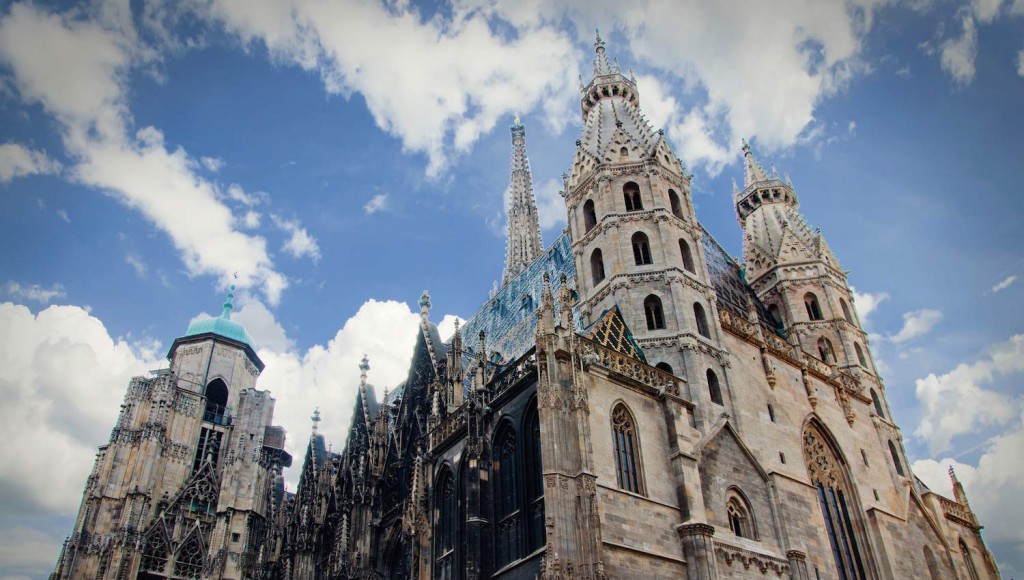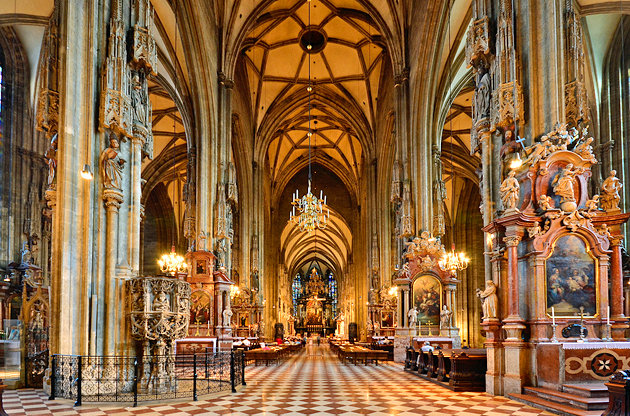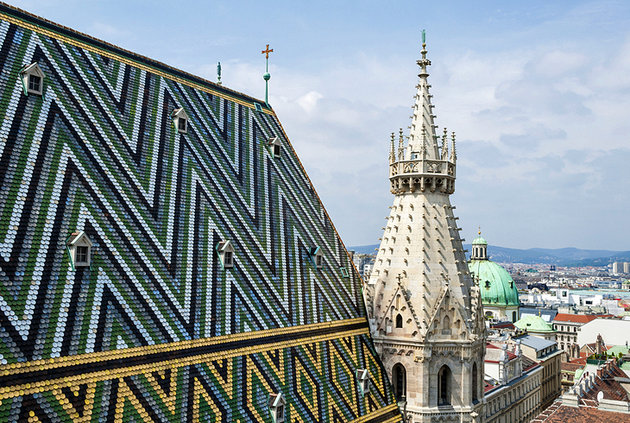St. Stephen's: the cathedral that monitors the city
INTRODUCTION
St. Stephen’s Cathedral (Stephansdom) is not only the main Roman Catholic church in Vienna– and the seat of the city’s Archbishop – it’s also one of Austria’s most popular attractions, welcoming more than a million guests each year. With its 137-meter-high spire and richly decorated roof, it’s the city’s most important Gothic edifice and represents eight centuries of architectural history. All that remains of the original 13th-century structure are the massive gate and the Heathen Towers (Heidentürme). Next, came reconstruction in Gothic style in the 14th century and the completion of the choir and the Chapels of St. Eligius, St. Tirna, and St. Catherine, while the South Tower, the Nave, and the Chapel of St. Barbara were added in the 15th century. During WWII, the building experienced nearly complete destruction. Its reconstruction, from 1948 until 1962, proved to be a tremendous communal effort involving the whole of Austria, demonstrating the nation’s eagerness to restore this former symbol of the country’s illustrious past.
WHAT'S INSIDE?
The first thing you’ll see as you enter the cathedral is the Late Romanesque Giant’s Door, notable for its uncommonly rich ornamentation of dragons, birds, lions, monks, and demons (it was named after the mastodon bone found during construction in 1443). Also of note is the Bishop’s Gate, originally reserved for female visitors and boasting fine figurative sculptures from 1370, along with a number of coats-of-arms. The Singer Gate was the entry for male visitors, and is notable for its figures of the Apostles and the legend of St. Paul dating from 1378.
The spacious three-aisled interior of St. Stephen’s is divided by clustered pillars on which are life-size statues, including one of St. Christopher dating from 1470. The 16th-century pulpit is the most important work of art in the nave, a masterpiece of Late Gothic sculpture decorated with the figures of the Four Fathers of the Church and, on the plinth, a representation of the sculptor, Master Pilgram, carved in the pose of a Peeping Tom. The Servants’ Madonna dates from 1340 and, according to legend, was made after a maid turned to the Virgin for help after being wrongly accused of theft (she was soon after proven innocent).
Another interior highlight is the magnificent Late Gothic Organ Case from 1513, also by Pilgram (he’s the figure with the compass and set square). Among the most notable of the cathedral’s many Early Gothic stone figures is an especially fine Angel of the Annunciation and a statue of Our Lady the Protectress in the Women’s Choir. Other highlights include the Wiener-Neustadter Altar from 1447 and the black marble High Altar from 1640, its statues representing the patron saints of the province, Leopold and Florian, and St. Roch and St. Sebastian, who were invoked in time of plague.
Also of note is Friedrich III’s Raised Sepulchre in the south choir. Made of red marble and including a larger-than-life-size statue of the Emperor surrounded by coats of arms, the design is by Dutch artist Niclas Gerhaert van Leyden (1467-1513) who also made the top of this Gothic grave. The 15th-century Late Gothic Canopy over the Leopold Altar is also worth seeing, as is the Pötscher Madonna, an object of veneration in Austria and Hungary since the Battle of Zenta in 1697 when, according to legend, tears streamed from the eyes of the Madonna for a fortnight at the time of the battle against the Turks.
In the foyer the public is met by a light, open space with a large, undulating oakwood wall. Behind this wall are the opera house’s three performance halls, with the Main House forming the heart of the building. Acoustic requirements determined the interior design of the Main House, and the combination of timbre and tonal possibilities and the dark, golden woodwork can be said to have transformed the Main House into a singularly outsized wooden instrument.
Oslo Opera House also has two smaller stages – the Second House and the Studio. Advanced theatre technology, specially built workshops, and rehearsal rooms for dance, song, orchestra and chorus make Oslo Opera House a modern, fully integrated performance venue. Every step in the process of creating performance art can be completed here.
THE CHAPEL
The first of many chapels you’ll see is the Tirna Chapel, built in 1359 and the burial place of Prince Eugene, conqueror of the Turks. In addition to the 15th-century Crucifix above the altar, take a peek at the beard of Christ: it’s made of human hair and, according to legend, is still growing. The most notable features of the Catherine Chapel are its marble font from 1481, and the reliefs on the 14-sided basin depicting Christ, John the Baptist, and the Twelve Apostles, while on its plinth are the Four Evangelists. Also worth visiting is the Eligius Chapel, or Dukes’ Chapel, with its important 14th-century statues.
THE TOWER
St. Stephen’s is particularly famous for its majestic towers, which have dominated Vienna’s skyline for centuries. The tallest of these is the Steffl, as the Viennese call the South Tower. Begun in 1356, it stands 137-meters high and is considered the most beautiful German Gothic tower in Europe thanks to features such as the statues below the richly ornamented canopies on the second floor. While it’s a tough climb up the 343 steps to the Watch Room, it’s worth it for the spectacular views over the city. Also worth visiting is the Cathedral’s North Tower, home to the massive Pummerin Bell, rung only on special occasions such as New Year’s Eve (a fast lift takes visitors to a viewing platform).
THE CATACOMBS AND THE CATHEDRAL TREASURE
The entrance to the must-see Catacombs is through a chamber under the North Tower of St. Stephen’s. Accessible only as part of a guided tour, they extend from the Cathedral Choir all the way to Stephansplatz and include the bones of around 10,000 Viennese citizens stacked up in tiers (this part is not open to the public). Constructed at the end of the 14th-century to house remains from the area’s overcrowded graveyards, the Catacombs were closed in 1783. Today, the major attraction is the Ducal Vault, which Rudolf IV had constructed for the Habsburgs in 1363. Also worth seeing is the Cathedral Treasure. In the West Gallery, this fascinating exhibit houses many of the church’s most important – and valuable -objects.

Vienna from the top of the Cathedral
Credits:
- Video: ricksteves.com
- Information and images: planetware.com


